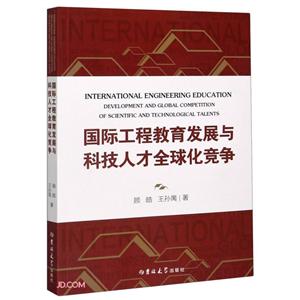掃一掃
關(guān)注中圖網(wǎng)
官方微博
¥19.9(3.4折)?
預(yù)估到手價是按參與促銷活動、以最優(yōu)惠的購買方案計算出的價格(不含優(yōu)惠券部分),僅供參考,未必等同于實際到手價。
促銷活動:
本類五星書更多>
-
>
妙相梵容
-
>
基立爾蒙文:蒙文
-
>
我的石頭記
-
>
心靈元氣社
-
>
女性生存戰(zhàn)爭
-
>
縣中的孩子 中國縣域教育生態(tài)
-
>
(精)人類的明天(八品)
國際工程教育發(fā)展與科技人才全球化競爭 版權(quán)信息
- ISBN:9787569272925
- 條形碼:9787569272925 ; 978-7-5692-7292-5
- 裝幀:暫無
- 冊數(shù):暫無
- 重量:暫無
- 所屬分類:>>
國際工程教育發(fā)展與科技人才全球化競爭 內(nèi)容簡介
本書旨在通過整合對全球創(chuàng)新、知識轉(zhuǎn)移、流動性和政府相關(guān)政策的分析, 擴展各國對全球人力資源在科學(xué)和技術(shù) (HRST) 流動性維度的理解。該書借鑒了非常有價值的評價和清單、分析文獻以及OECD成員國和其他觀察國的*新統(tǒng)計數(shù)據(jù), 以解釋全球人力資源在科學(xué)和技術(shù)流動中的政策影響、層面和意義。
國際工程教育發(fā)展與科技人才全球化競爭 目錄
Chapter 1: Engineering Technology Education in the United States
1.1 Introduction
1.2 Engineering technology education in the U. S. (Instructions, programs, and accreditation)
1.3 The nature of engineering technology education
1.4 Engineering technology education supply and demand
1.5 Licensing,certification and equivalency
1.6 Recommendations
Chapter 2: The Production of Engineering Technology Talents in the United States
2.1 Introduction
2.2 Trends in degree production
2.3 Educational composition of the engineering technology workforce
2.4 Demographics: diversity
2.5 Work-based education and training
2.6 Community college experiences and connections to pre K-12 education
Chapter 3: The Employment of Engineering Technology Talents in the OECD Countries
3.1 Introduction
3.2 Size and composition of the engineering technology work force
3.3 Trends in employment,income,and age
3.4 Work rules, skills, and job performance
3.5 Career pathways and hiring patterns
3.6 Shortages
3.7 The impact of automation and technological development
Chapter 4: The Global Competition for Engineering Technology Talents-Discussion on the OECD Countries' Labor Market
4.1 Knowledge diffusion and impacts of international mobility
4.2 International mobility and its impact
4.3 Mobility strategies and current policy approaches
4.4 Suggestion for government intervention and future mobility policy suggestion
Chapter 5: The Significant Relationships between Culture, Physical Environment, Geographical Location, and the Success of Technology Transfer: A Case Study and OECD Countries Private Manufacturing Industries
5.1 Introduction
5.2 Cultural factors
5.3 Cross-cultural theories
5.4 Leadership and culture
5.5 Case study:A private Chinese firm-Huawei
5.6 Discussion on OECD countries private manufacturing industries
5.7 Conclusion
Chapter 6: Analysis on Engineering Technology Education in the United States and Other OECD Countries
6.1 Introduction
6.2 Present situation and characteristics of engineering technology education in the United States and other OECD countries
6.3 Strategies for science, technology, engineering and math in engineering technology education
6.4 The impact of engineering technology education on regional industrial competitiveness
6.5 Future development of engineering technology education in the United States and other OECD countries
6.6 Findings and conclusions
References
1.1 Introduction
1.2 Engineering technology education in the U. S. (Instructions, programs, and accreditation)
1.3 The nature of engineering technology education
1.4 Engineering technology education supply and demand
1.5 Licensing,certification and equivalency
1.6 Recommendations
Chapter 2: The Production of Engineering Technology Talents in the United States
2.1 Introduction
2.2 Trends in degree production
2.3 Educational composition of the engineering technology workforce
2.4 Demographics: diversity
2.5 Work-based education and training
2.6 Community college experiences and connections to pre K-12 education
Chapter 3: The Employment of Engineering Technology Talents in the OECD Countries
3.1 Introduction
3.2 Size and composition of the engineering technology work force
3.3 Trends in employment,income,and age
3.4 Work rules, skills, and job performance
3.5 Career pathways and hiring patterns
3.6 Shortages
3.7 The impact of automation and technological development
Chapter 4: The Global Competition for Engineering Technology Talents-Discussion on the OECD Countries' Labor Market
4.1 Knowledge diffusion and impacts of international mobility
4.2 International mobility and its impact
4.3 Mobility strategies and current policy approaches
4.4 Suggestion for government intervention and future mobility policy suggestion
Chapter 5: The Significant Relationships between Culture, Physical Environment, Geographical Location, and the Success of Technology Transfer: A Case Study and OECD Countries Private Manufacturing Industries
5.1 Introduction
5.2 Cultural factors
5.3 Cross-cultural theories
5.4 Leadership and culture
5.5 Case study:A private Chinese firm-Huawei
5.6 Discussion on OECD countries private manufacturing industries
5.7 Conclusion
Chapter 6: Analysis on Engineering Technology Education in the United States and Other OECD Countries
6.1 Introduction
6.2 Present situation and characteristics of engineering technology education in the United States and other OECD countries
6.3 Strategies for science, technology, engineering and math in engineering technology education
6.4 The impact of engineering technology education on regional industrial competitiveness
6.5 Future development of engineering technology education in the United States and other OECD countries
6.6 Findings and conclusions
References
展開全部
國際工程教育發(fā)展與科技人才全球化競爭 作者簡介
王孫禺,清華大學(xué)教授,博士生導(dǎo)師,聯(lián)合國教科文組織國際工程教育中心副主任兼秘書長,中國工程教育認證協(xié)會常務(wù)理事,中國高等工程教育專業(yè)委員會理事,清華大學(xué)教育研究所原所長,清華大學(xué)人文社會科學(xué)學(xué)院原院務(wù)委員會主任。
書友推薦
- >
人文閱讀與收藏·良友文學(xué)叢書:一天的工作
- >
有舍有得是人生
- >
推拿
- >
我從未如此眷戀人間
- >
中國歷史的瞬間
- >
二體千字文
- >
姑媽的寶刀
- >
羅庸西南聯(lián)大授課錄
本類暢銷


















